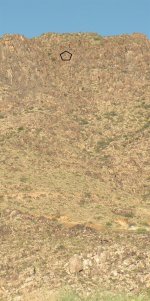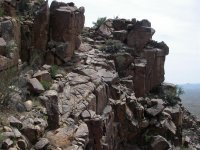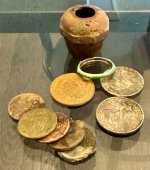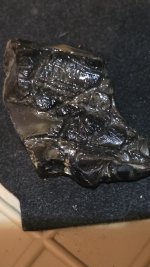sandy1
Bronze Member
- Aug 11, 2010
- 2,282
- 4,594
- Primary Interest:
- Other
- Thread starter
- #2,661
Here is what I meant about being stuck on the writings/graffiti on the rocks.
Many of the markers that you find in the field are used at multiple sites and will be in the same type of locations such as a base of a hill or in a wash, this was due to the fact that there were rules that were followed and therefore the people that came back for these caches knew what to do when they found a certain marker in a certain spot, in otherwords it was understood what to do once they found a Owl or Duck etc. in a specific area and there was no need for any explanations on the rocks/boulders themselves as too what to do next, this also prevents anybody outside the recovery people from figuring out what to do with the markers.
Now back to the picture.
The purpose of this boulder is simple, it is there to stop you as you are going along the base of the mountain and tells you to look up the mountain behind it, you might be wondering how I know what direction to look since there is nothing on the boulder that would indicate a direction to look, it was understood that the boulder is directly below/downhill from the Important cache that is up the hill from it and to ad to this info the closest 15 degrees on a compass that is going up this mountain from the boulder to the cache is 75 Degrees.
Here is the Boulder with the cache location, I am marking the cache location with a pentagon, this is how simple this stuff really is (until you get within 100 feet then it gets complicated), if you get hung up in all the writing/graffiti you will be completely lost and not even get close to where you should be.

Many of the markers that you find in the field are used at multiple sites and will be in the same type of locations such as a base of a hill or in a wash, this was due to the fact that there were rules that were followed and therefore the people that came back for these caches knew what to do when they found a certain marker in a certain spot, in otherwords it was understood what to do once they found a Owl or Duck etc. in a specific area and there was no need for any explanations on the rocks/boulders themselves as too what to do next, this also prevents anybody outside the recovery people from figuring out what to do with the markers.
Now back to the picture.
The purpose of this boulder is simple, it is there to stop you as you are going along the base of the mountain and tells you to look up the mountain behind it, you might be wondering how I know what direction to look since there is nothing on the boulder that would indicate a direction to look, it was understood that the boulder is directly below/downhill from the Important cache that is up the hill from it and to ad to this info the closest 15 degrees on a compass that is going up this mountain from the boulder to the cache is 75 Degrees.
Here is the Boulder with the cache location, I am marking the cache location with a pentagon, this is how simple this stuff really is (until you get within 100 feet then it gets complicated), if you get hung up in all the writing/graffiti you will be completely lost and not even get close to where you should be.

Last edited:



 thanks !
thanks !


